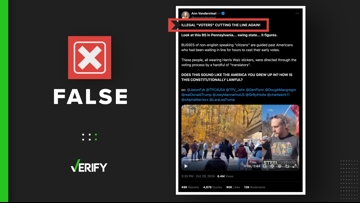A bipartisan group of senators proposed a multi-billion dollar bill to provide foreign aid to Ukraine and Israel, while also overhauling U.S. border security.
But, on Thursday, Feb. 7, Senate Republicans blocked the border proposal, which had momentum in Congress until former President Donald Trump and several of his allies voiced their opposition to it.
Trump claimed the bill would “allow 5,000 [migrants] into our country a day,” a claim the bill’s chief sponsor Sen. James Lankford (R-Okla.) denied.
THE QUESTION
Would the bipartisan border bill have allowed 5,000 migrants into the United States per day?
THE SOURCES
THE ANSWER
This claim is misleading. The bill would have given Border Patrol agents the ability to immediately deport people once agents encounter an average of 5,000 migrants per day over the course of a week. But an “encounter'' isn't the same as letting someone into the U.S.
WHAT WE FOUND
Under existing immigration laws, migrants who cross the border – legally or illegally – can request asylum, and then are released into the U.S. while they await a hearing on the validity of their claim, which can take years.
The Senate proposal would have overhauled that system. Instead of being released after entering the U.S., most migrants claiming asylum would have been detained. And instead of waiting years for a formal hearing, they would receive a first-pass interview within 90 days. The bill also would have put stricter criteria in place for asylum eligibility and applicants not meeting that threshold would have been sent into expedited deportation proceedings.
The bill included billions of dollars to hire more staff at the border, but the bill authors recognized the proposed protocols could overwhelm the current system. That’s why they drafted a provision called the Border Emergency Authority. This provision is where the “5,000” number comes from.
The emergency authority would give border agents the power to immediately turn away any migrants they encounter at the border without hearing their asylum claims. This would go into effect when the number of encounters surpasses a certain threshold: either an average of 5,000 per day over the course of a week, or 8,500 in a single day.
Once activated, this emergency authority would not be lifted until the average number of encounters over the course of a week drops below 3,750 per day. Until that number is reached, Border Patrol would not process any new, unscheduled asylum claims.
Asylum seekers with scheduled appointments at dedicated ports of entry would still have been able to have their claims processed while the authority is activated.
U.S. Customs and Border Protection data shows that encounters are currently above the 5,000 threshold and have been for almost all of the last three years. That means if the bill had passed, the emergency authority would have almost immediately taken effect and resulted in faster deportations.
The Border Emergency Authority was modeled after the Trump administration’s use of Title 42, which applied a public health statute to allow border agents to reject migrants at the border without hearing asylum claims during the COVID-19 pandemic.
Because the authority would not have automatically gone into effect until the 5,000-encounter daily threshold is reached, critics of the bill have claimed it would have effectively allowed 5,000 people to enter the U.S. per day. That’s misleading.
Not all border encounters are asylum seekers, and a significant percentage of people requesting asylum are denied and deported.
If, in theory, all 5,000 encounters were different people each claiming asylum, those claims would be processed under the bill. However, the applicants would not be simply “let in” to the country: single adults would be detained and families with children would be placed in monitoring programs until their initial interview.












